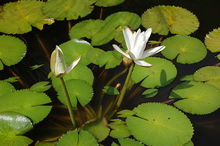Nymphaeales: Difference between revisions
m Citation maintenance. You can use this bot yourself! Please report any bugs. |
add fossil section |
||
| Line 13: | Line 13: | ||
This order is considered to be a basal, or early diverging, group of angiosperms. The families of this order are united by being families of aquatic herbs and are known from the fossil record as early as the Lower Cretaceous. |
This order is considered to be a basal, or early diverging, group of angiosperms. The families of this order are united by being families of aquatic herbs and are known from the fossil record as early as the Lower Cretaceous. |
||
== Fossils == |
|||
There are many fossils of seeds, and also fossils of pollen, stems, leaves, and flowers back to the [[Cretaceous]].<ref>{{cite web | url = http://www.ucmp.berkeley.edu/anthophyta/paleoherbs/nymphfr.html | title = Nymphaeales: Fossil Record | publisher = University of California Museum of Paleontology}}</ref><ref>{{cite journal | doi = 10.1038/35066557}}</ref> |
|||
It is posssible that the aquatic plant fossil ''[[Archaefructus]]'' belongs to this group.<ref>{{cite journal | url = http://www.annalsnyas.org/cgi/content/abstract/1133/1/3 | title = The Year in Evolutionary Biology 2008 | date = published June 2008 | journal = Ann. N.Y. Acad. Sci. | volume = 1133 | pages = 3–25 | doi = 10.1196/annals.1438.005 }}</ref> |
|||
== In different classification systems == |
|||
====Cronquist==== |
====Cronquist==== |
||
Revision as of 01:32, 9 July 2008
| Nymphaeales | |
|---|---|

| |
| Nymphaea lotus | |
| Scientific classification | |
| Kingdom: | |
| Division: | |
| Class: | |
| Order: | Nymphaeales |
Nymphaeales is a botanical name at the rank of order. When recognized, it includes water lilies and sometimes other aquatic plants. This order is not part of the APG II system's 2003 plant classification (unchanged from the APG system of 1998), which instead has a broadly circumscribed family Nymphaeaceae (including Cabombaceae) unplaced in any order. It is recognized by some systems of plant taxonomy, but others use different placements for the families in this order. In particular some plant systematists using the APG II system now use this order and circumscribe it to include the Nymphaeaceae and Cabombaceae. A 2007 study has found that Hydatellaceae also belongs to this group.[1]
This order is considered to be a basal, or early diverging, group of angiosperms. The families of this order are united by being families of aquatic herbs and are known from the fossil record as early as the Lower Cretaceous.
Fossils
There are many fossils of seeds, and also fossils of pollen, stems, leaves, and flowers back to the Cretaceous.[2][3]
It is posssible that the aquatic plant fossil Archaefructus belongs to this group.[4]
In different classification systems
Cronquist
The Cronquist system, of 1981, placed it in subclass Magnoliidae, in class Magnoliopsida [=dicotyledons] of division Magnoliophyta [=angiosperms]. It used this circumscription:
- order Nymphaeales
- family Nelumbonaceae
- family Nymphaeaceae
- family Barclayaceae
- family Cabombaceae
- family Ceratophyllaceae
Thorne (1992)
The Thorne system (1992) placed it in superorder Nymphaeanae in subclass Magnoliideae [=dicotyledons] in class Magnoliopsida [=angiosperms]. It used this circumscription:
- order Nymphaeales
- family Cabombaceae
- family Nymphaeaceae
Dahlgren
The Dahlgren system placed it in superorder Nymphaeanae, in subclass Magnoliideae [=dicotyledons], in class Magnoliopsida [=angiosperms]. It used this circumscription:
- order Nymphaeales
- family Cabombaceae
- family Nymphaeaceae
- family Ceratophyllaceae
References
- ^ Saarela; et al. (2007). "Hydatellaceae identified as a new branch near the base of the angiosperm phylogenetic tree". Nature. 446 (7133): 312–5. doi:10.1038/nature05612. PMID 17361182.
{{cite journal}}: Explicit use of et al. in:|author=(help) - ^ "Nymphaeales: Fossil Record". University of California Museum of Paleontology.
- ^ . doi:10.1038/35066557.
{{cite journal}}: Cite journal requires|journal=(help); Missing or empty|title=(help) - ^ "The Year in Evolutionary Biology 2008". Ann. N.Y. Acad. Sci. 1133: 3–25. published June 2008. doi:10.1196/annals.1438.005.
{{cite journal}}: Check date values in:|date=(help)
- Simpson, M.G. Plant Systematics. Elsevier Academic Press. 2006.
